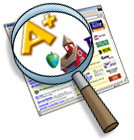|
Volume 6, Issue 4
February 18, 2008
A WORD ABOUT THIS ISSUE'S THEME
 As a teacher, you have the wonderful opportunity to introduce young children to literature. What could be more exciting than watching your students see history in a folktale? Laugh out loud at a well-told story? Learn the rhyme in poems? Or begin to appreciate the richness of colorful illustrations? As a teacher, you have the wonderful opportunity to introduce young children to literature. What could be more exciting than watching your students see history in a folktale? Laugh out loud at a well-told story? Learn the rhyme in poems? Or begin to appreciate the richness of colorful illustrations?
Do you know that Read Across America Day is just around the corner? On Monday, March 3, students across the nation will celebrate books (and Dr. Seuss's birthday) but planning special reading events. What better time than this to dive into a unit on literature? The activities and resources we suggest below will help you do just that.
Susan LaBella
Editor, Early Childhood Education Newsletter
ACTIVITY IDEAS
 BROWN BEAR, BROWN BEAR BROWN BEAR, BROWN BEAR
Read to children Brown Bear, Brown Bear, What Do You See? by Bill Martin. After reading:
--- Point out each animal in the book to your children. Let them name the color of the animal and make the sound the animal makes.
--- Create a bear-shaped class booklet. Ask each child to draw a picture of something else Brown Bear might have seen (for example, a golden dinosaur). Bind the pages together and leave the book in your classroom reading center for children to share.
--- Give each child a precut bear-shaped sheet of paper and a small cup of chocolate pudding. Let children use the pudding to fingerpaint their bear shapes to create a brown bear. Students can eat any pudding that remains.
CLOUDY WITH WHAT???
Share with students Judi and Ron Barrett's book Cloudy With a Chance of Meatballs. Invite them to think about living in a place where food falls from the sky. Ask what would be good about living in such a place? What might not be so good? Record student responses in a list on an easel pad. Let each student draw a picture to illustrate his/her response. Then help students copy their responses from the list to the bottom of their picture pages.
A BIG BLUE OX
Help children understand the concept of a folktale. Explain that it is a story from long ago that was told over and over again. Over many years the story was passed from person to person, so no one really knows who started the story. Read to children Paul Bunyan, by Steven Kellogg. Encourage discussion by asking: Who helped Paul? Why did Paul chop down trees? How did he get rid of the tree stumps? When children have a good sense of the story's progression, invite them to make layer books. For each student, arrange 3 sheets of copy paper so that each sheet is about an inch lower than the one before it. Take all 3 pages and fold them in the middle of the first page. Staple the book along the "spine." The result will be a book with pages that stick out like tabs. On each tab help students write a word: "Beginning," "Middle," or "End." Talk about what took place in each part of the folktale and let students draw a picture to show that. There will be some extra pages in the booklet; on those pages students can write the book title or any big words from the story.
A SPECIAL FISH
The story of The Rainbow Fish by Marcus Pfister is about a small fish that learns to share. After reading the book aloud, help children make their own rainbow fish. Give each child a coffee filter and have him/her flatten it out. Let children color the filter with various colored markers. Children can use a spray bottle to spray a bit of water onto their colored filters. Set the filters aside to dry. When the filters are dry, cut a fish shape out of each one for each child. Help children glue strips and triangles (for scales) of aluminum foil onto their fish. Finally glue a googly eye onto the fish and let children draw a mouth.
THE DOORBELL RANG
To prepare, use a tube of pre-packaged cookie dough to bake one large chocolate chip cookie. Cut a cardboard door into one side of an appliance box and cut out the back side of the box. Place a hand bell on a table. Read to children The Doorbell Rang, by Pat Hutchins. Separate the class into groups of varying numbers -- 2, 3, 6, and so on. Have one group ring the bell and come through the "door." Draw a circle on the board and discuss ways to divide one large cookie so each person can have an equal part. Repeat for the remaining groups. Finally when all the children are in, divide the cookie so everyone has an equal share and enjoy!
ON THE WEB
 Brown Bear, Brown Bear, What Do You See? Brown Bear, Brown Bear, What Do You See?
Printable pages of animals from the book, plus lots of activity suggestions.
http://www.dltk-teach.com/books/brownbear/index.htm
The Kissing Hand Game
After reading to children the book by Audrey Penn, print and cut out these cards for children to use in your math center.
http://www.archjrc.com/childsplace/kissinghand.html
Pumpkin, Pumpkin Sequencing Activity
Use this nice sequencing activity as a follow-up to reading Pumpkin Pumpkin by Jeanne Titherington.
http://www.atozteacherstuff.com/pdf.htm?pumpkin_lesson.pdf
ThemeLinks.com
From apples to worms… you'll find the theme you're looking for -- including activities, poems, songs, and more great literature links.
http://www.themelinks.com/
Nursery Rhyme Resources
Try this site for rhymes, stories, and book suggestions.
http://www.geocities.com/soogal99/nursery.html
|